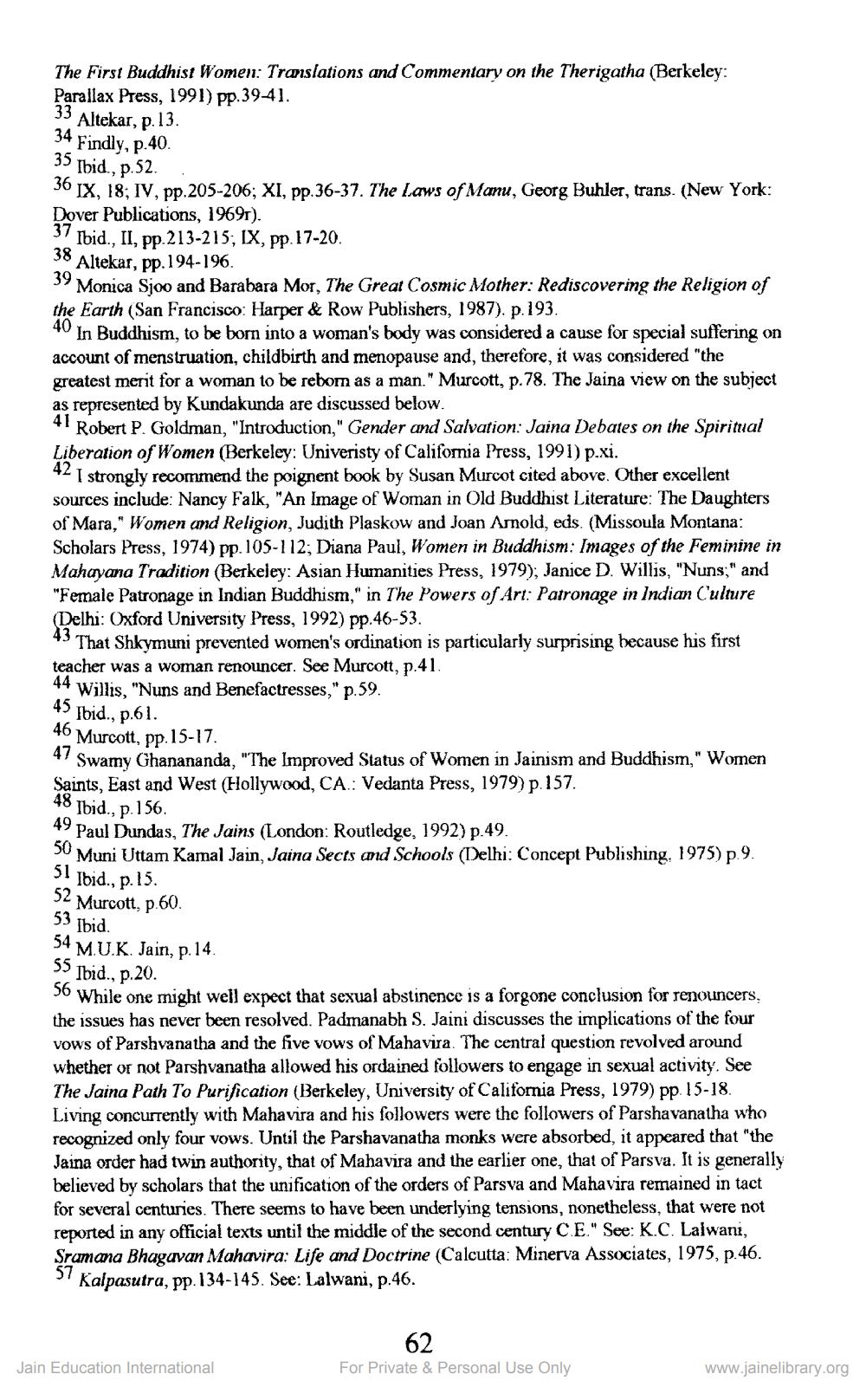________________
The First Buddhist Women: Translations and Commentary on the Therigatha (Berkeley: Parallax Press, 1991) pp. 39-41. 33 Altekar, p.13. 34 Findly, p.40. 35 Ibid., p.52 30 IX, 18; IV, pp. 205-206; XI, pp. 36-37. The laws of Manu, Georg Buhler, trans. (New York: Dover Publications, 1969). 3/ Ibid., II, pp. 213-215; IX, pp. 17-20. 38 Altekar, pp. 194-196. 39 Monica Sjoo and Barabara Mor, The Great Cosmic Mother: Rediscovering the Religion of the Earth (San Francisco: Harper & Row Publishers, 1987). p.193. 40 In Buddhism, to be born into a woman's body was considered a cause for special suffering on account of menstruation, childbirth and menopause and, therefore, it was considered "the greatest merit for a woman to be reborn as a man." Murcott, p.78. The Jaina view on the subject as represented by Kundakunda are discussed below. 4. Robert P. Goldman, "Introduction," Gender and Salvation: Jaina Debates on the Spiritual Liberation of Women (Berkeley: Univeristy of California Press, 1991) p.xi. 42 I strongly recommend the poignent book by Susan Murcot cited above. Other excellent sources include: Nancy Falk, "An Image of Woman in Old Buddhist Literature: The Daughters of Mara," Women and Religion, Judith Plaskow and Joan Amold, eds. (Missoula Montana: Scholars Press, 1974) pp. 105-112, Diana Paul, Women in Buddhism: Images of the Feminine in Mahayana Tradition (Berkeley: Asian Humanities Press, 1979); Janice D. Willis, "Nuns;" and "Female Patronage in Indian Buddhism," in The Powers of Art: Patronage in Indian Culture (Delhi: Oxford University Press, 1992) pp.46-53. 43 That Shkymuni prevented women's ordination is particularly surprising because his first teacher was a woman renouncer. See Murcott, p.41. 44 Willis, "Nuns and Benefactresses," p.59. 45 Ibid., p.61. 46 Murcott, pp.15-17.
Swamy Ghanananda, "The Improved Status of Women in Jainism and Buddhism," Women Saints, East and West (Hollywood, CA.: Vedanta Press, 1979) p. 157.
48 Ibid., p. 156.
* Paul Dundas, The Jains (London: Routledge, 1992) p.49. 30 Muni Uttam Kamal Jain, Jaina Sects and Schools (Delhi: Concept Publishing, 1975) p. 9.
Ibid., p.15. Murcott, p.60.
Ibid. 54 M.U.K. Jain, p.14.
35 Ibid., p.20.
56 While one might well expect that sexual abstinence is a forgone conclusion for renouncers, the issues has never been resolved. Padmanabh S. Jaini discusses the implications of the four vows of Parshvanatha and the five vows of Mahavira. The central question revolved around whether or not Parshvanatha allowed his ordained followers to engage in sexual activity. See The Jaina Path To Purification (Berkeley, University of California Press, 1979) pp. 15-18. Living concurrently with Mahavira and his followers were the followers of Parshavanatha who recognized only four vows. Until the Parshavanatha monks were absorbed, it appeared that "the Jaina order had twin authority, that of Mahavira and the earlier one, that of Parsva. It is generally believed by scholars that the unification of the orders of Parsva and Mahavira remained in tact for several centuries. There seems to have been underlying tensions, nonetheless, that were not reported in any official texts until the middle of the second century C.E." See: K.C. Lalwani, Srumana Bhagavan Mahavira: Life and Doctrine (Calcutta: Minerva Associates, 1975, p.46. » Kalpasutra, pp. 134-145. See: Lalwani, p.46.
62 For Private & Personal Use Only
Jain Education International
www.jainelibrary.org




